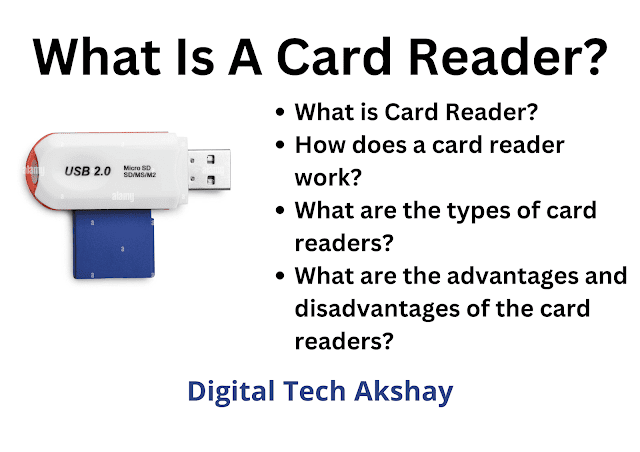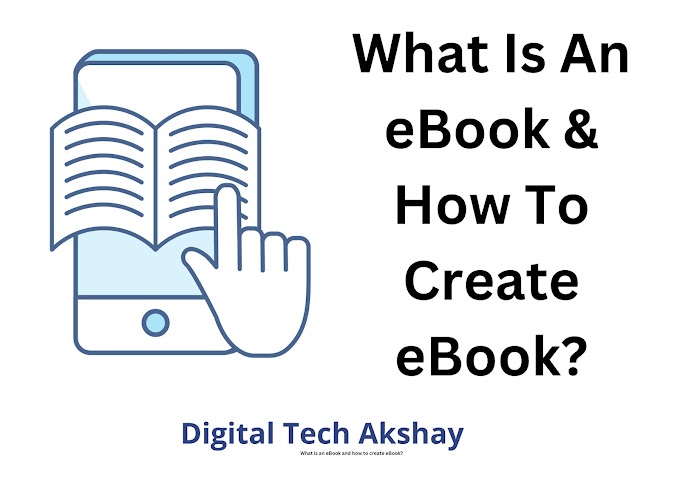What is a card reader:-
The card reader is such an input device that reads flash memory cards.
Card readers can also be connected as a standalone device to a computer via USB or they can also be integrated with a computer, printer, or any multifunction device. At the same time, built-in card readers are already being seen in almost all multifunction printers/scanners/copiers.
Most of card readers accept multiple memory card formats, including compact flash (CF), secure digital (SD), and Sony's Memory Stick. Whereas some card readers accept other formats as well such as XD, SmartMedia, Microdrive, and Memory Stick Pro Duo cards.
The main function of a Card Reader is to read the data located in a memory card. So when you put a memory card in a card reader and connect it to the computer, then it shows as a mounted disk.
On the other hand, if you want to see the contents of the memory card, then you have to double-click on the icon of that card. This icon typically appears on the desktop (if we talk about Macintosh computers) while it shows up within "My Computer" (if we talk about Windows machines).
Whereas if you want to remove the card, then you have to first unmount or "eject" that disk, before physically removing it. This prevents your memory card from getting corrupted.
To read any type of microchip, a card reader is required in the computer, without a card reader, no microchip is read in the computer.
There is a link between the computer and the microchip card reader by inserting a microchip in a card reader and then connecting to the computer then any type of file folder audio video can be inserted in that chip.
History:-
A card Reader is an input device in which audio and video can be played by storing any type of audio video off file and in any other music system music player.
Going back to the history of card readers, punch cards were first used to store data. The idea of control and data storage by means of punch cards was developed over a long period of time. In most cases, there is no evidence today that each inventor had any knowledge of the earlier work. A punch card is a piece of rigid paper containing digital data represented by the presence or absence of holes in predetermined positions.
Punch developed gambling for card readers and punch card machines that were more easily adaptable for computer use. Forrest Corry Parry was an IBM engineer who invented the magnetic stripe card used for credit cards and identification badges in 1969. In March 1979, Michel Hugon of the Bull CP8 was the first to design and develop a microprocessor-based card combining a processor and local memory. He designed and invented the computerized smart card.
1991 The first NAND-type flash memory technology was also introduced to the market by Toshiba. NAND-type flash memory was a new and improved configuration that reduced the memory cell area so that lower bit cost could be achieved. Both types of flash memory readers were invented by Dr. Fujio Masuoka did it while working for Toshiba in the 1980s.
How do card readers work?:-
Today's payment cards contain the cardholder's personal information either on a magnetic stripe, or a microchip, or both. The card reader is an essential component of today's modern payment processing system. They have become ubiquitous today in recent years, commonly used in retail stores point-of-sale (POS) terminals as well as in automated teller machines (ATMs) offered by banks. By using card readers, merchants are able to accept credit and debit card purchases from customers and can greatly increase transaction speed.
A memory card reader is a device for accessing data on a memory card such as CompactFlash (CF), Secure Digital (SD), or MultiMediaCard (MMC). Most memory card readers also offer writing capability, and with the card, it can act as a pen drive.
In most access control systems, the card reader emits a signal that picks up and reads data stored on the access control card. Access control cards have an antenna and can transmit data stored on the card's chip directly to a reader.
Types of Card Readers:-
Friends, there are different types of card readers available in the market according to their functions.
- Smart Card Reader
- Memory Card Reader
- Access Control Card Reader
Let us now understand these four one by one.
1) Smart Card Reader:-
A smart card reader is a device used to read smart cards, such as microprocessor cards. This card reader is made of plastic in which the chip is embedded, which is read by the smart card reader. Smart cards are generally used by companies or organizations for data security.
२) Memory Card Reader:-
A memory card reader is a device used to access data from memory cards such as Compact Flash (CF), Secure Digital (SD), Multi-Media cards, etc. The memory card readers can read and write the data present in the memory card.
3) Access Control Card Reader:-
Access Control Card Reader is used to read the given Credential, it checks it in the database present inside the Access Control Software. This type of card reader is mainly used in businesses. It is safe and convenient.
Which device is a card reader?:-
The card reader is an input device. A card Reader is an Input Device User input data transfer from a computer card reader then it is called Input Device. Since the card reader provides input data to the computer, it is considered an input device. For example, when a user inserts a memory card into a card reader, the data from the memory card is transferred to the computer's hard drive.









0 Comments